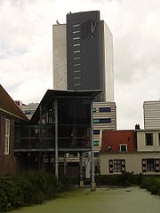
Naturalis
Encyclopedia

Natural History Museum
The Natural History Museum is one of three large museums on Exhibition Road, South Kensington, London, England . Its main frontage is on Cromwell Road...
of the Netherlands
Netherlands
The Netherlands is a constituent country of the Kingdom of the Netherlands, located mainly in North-West Europe and with several islands in the Caribbean. Mainland Netherlands borders the North Sea to the north and west, Belgium to the south, and Germany to the east, and shares maritime borders...
, based in Leiden. It originated from the merger of the Rijksmuseum van Natuurlijke Historie
Rijksmuseum van Natuurlijke Historie
The Rijksmuseum van Natuurlijke Historie was a museum in Leiden, The Netherlands. It was founded in 1820 by Royal Decree, formed from a merger of several existing collections. This happened at the instigation of Coenraad Jacob Temminck, who saw the museum primarily as a research institute...
(abbreviated RMNH) and the Rijksmuseum van Geologie en Mineralogie
Rijksmuseum van Geologie en Mineralogie
-History :Up to 1878, geological and mineralogical collections formed part of "s Rijks Museum van Natuurlijke Historie', the National Museum of Natural History....
(abbreviated RGM) in 1984. In 1986 it was decided that the museum had to become a public museum and a new building was built. The new building cost about €60 million, making it the second most expensive museum building in the Netherlands.
The museum is open every day of the week from 10am to 5pm. The entry fee is €7.00 for people aged 4 to 12, €9.00 for people aged 13 to 17, €11.00 for people aged 18 to 65, and €10.00 for people aged above 65.
Collection
The current museum is known for the numerous objects in its collections. It has approximately 10 million zoological and geological specimens.- 5,250,000 insectInsectInsects are a class of living creatures within the arthropods that have a chitinous exoskeleton, a three-part body , three pairs of jointed legs, compound eyes, and two antennae...
s - 2,290,000 other invertebrateInvertebrateAn invertebrate is an animal without a backbone. The group includes 97% of all animal species – all animals except those in the chordate subphylum Vertebrata .Invertebrates form a paraphyletic group...
s - 1,000,000 vertebrateVertebrateVertebrates are animals that are members of the subphylum Vertebrata . Vertebrates are the largest group of chordates, with currently about 58,000 species described. Vertebrates include the jawless fishes, bony fishes, sharks and rays, amphibians, reptiles, mammals, and birds...
s - 1,160,000 fossilFossilFossils are the preserved remains or traces of animals , plants, and other organisms from the remote past...
s - 440,000 rocksRock (geology)In geology, rock or stone is a naturally occurring solid aggregate of minerals and/or mineraloids.The Earth's outer solid layer, the lithosphere, is made of rock. In general rocks are of three types, namely, igneous, sedimentary, and metamorphic...
and mineralMineralA mineral is a naturally occurring solid chemical substance formed through biogeochemical processes, having characteristic chemical composition, highly ordered atomic structure, and specific physical properties. By comparison, a rock is an aggregate of minerals and/or mineraloids and does not...
s - 2,000 gemstoneGemstoneA gemstone or gem is a piece of mineral, which, in cut and polished form, is used to make jewelry or other adornments...
s - 10,000 objects in an educationEducationEducation in its broadest, general sense is the means through which the aims and habits of a group of people lives on from one generation to the next. Generally, it occurs through any experience that has a formative effect on the way one thinks, feels, or acts...
al collection
The collections will be fused with the collections of the Zoölogisch Museum Amsterdam and expanded to approximately 37 million specimens. The fusion started in 2011 and is scheduled to be competed in 2012.
The collections are stored in a 60-meter-high tower, a landmark in Leiden, opened in April 1998.
Exhibitions
Besides its temporary exhibition the museums has several permanent exhibitions:- Nature Theater (Animals, plants, fungi, one-celled organisms, bacteria, stones, and minerals: an impression of nature in all its various forms.)
- Primeval Parade (A parade of fossils shows the history of the earth and the development of life.)
- Earth (Games and signs inform the visitor about the Earth's complexities.)
- Life (It displays how plants and animals live and survive on earth. )
- Earth Inside (For children and their parents to discover in a playful way how nature works.)
- Biotechnology (Games and movies show the visitor how essential DNA is to all life processes.)
- Treasure Chamber (Special security and storage conditions protect the precious gemstones, including a collection that once belonged to the Dutch King William IWilliam I of the NetherlandsWilliam I Frederick, born Willem Frederik Prins van Oranje-Nassau , was a Prince of Orange and the first King of the Netherlands and Grand Duke of Luxembourg....
, and the mounted skins of animals that became extinct over the past few hundred years.)

